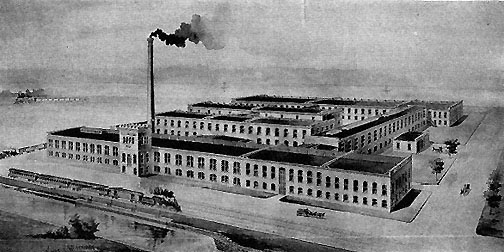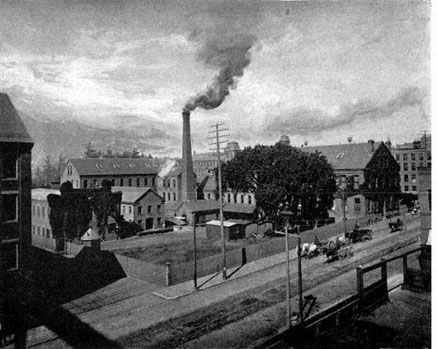The Norman Paper Company.
As the latest established of the new paper mills, that of the Norman Paper Company, at Holyoke, invites special attention, from the size of the plant and its thoroughly modern equipment.

Mills of the Norman Paper Company, Holyoke.
|
The Norman paper company was organized April, 1891, and was incorporated in May of the same year. The plant, which was designed by Architect Tower of Holyoke, is located at the corner of Appleton and Water streets, just north of the Connecticut river railroad bridge, and consists of nine buildings. These are all liberal size and equipped for the large business already on hand. The engine room is 221 x 46 feet, machine room is 184 x 60 feet, and other departments are in proportion, and all equipments of the most improved modern pattern.
The buildings are brick, laid in full cement up to the first floor, and half cement the rest of the way, and the roofs are flat and graveled. About six million of brick were used in construction, and about four thousand cubic years of stone masonry. The main walls are twenty inches thick. Fire walls separate the different rooms, and the doors are hung on self-closing trolley tracks and covered with tin. The timbers and floors and harness work for the machinery is of Southern pine, of which one and a-half million feet were used. The planking for the machine room floor is seven and one-fourth inches thick, and is bolted to steel T beams, which rest on the brick piers. A cement floor on corrugated iron and brick surround on the wt part of the paper machine.
The office building is finely fitted up, and contains a counting-room 17 x 32 feet, treasurer’s and president’s offices and closets, with California redwood and antique oak furnishings.
The hallway, forty feet long and six feet wide, is furnished in cherry. There is a superintendent’s office 16 x 18 feet, in which are shelves and cases for keeping samples. Also a storeroom 16 x 30 feet, for storage of the more expensive supplies. The offices are lighted with electric lights and gas, it being so arranged that on coming in it is possible to turn off a gas or electric light in any office from the hallway. Push buttons and electric bells form a complete system for calling.
The dynamo is located in the power house, is driven by water power, and furnished one hundred and fifty incandescent lights of sixteen candle power each. Underneath the offices is located the filter plant, of one thousand gallons per minute capacity, for filtering the wash water. The size of the mill site is 600 x 354 feet.
There is also a building of brick for the storage of lime and oils.
The buildings are equipped with new Grinnell automatic sprinklers, and nine two-way hydrants supplied with city water, at one hundred and ten pounds, furnish fire protection. A one-thousand gallon Clark Machine Company rotary fire pump furnishes water for the hydrants and sprinklers in case the city water is shut off. Shipping facilities are afforded by the tracks of the N.Y., N.H. & H.R.R. and Connecticut River R.R., running into the mill yard to the shipping and receiving platforms.
The capital stock of the company is $200,000. The officers of the company are: President, James H. Newton; treasurer, Frederick H. Newton; paymaster, Edward S. Towne; shipping and billing clerk, John W. Stebbins; superintendent, Henry L. DeWolf.
The company purpose to manufacture a high-class of animal-sized and machine-dried papers, competing with the loft-dried mills. The mill began running June 21, and had its first consignment ready for shipping June 24.
Interesting, as showing the artistic taste of its founder, is the handsome letter-heading of the new Norman mill, especially when studies in connection with that of the Wauregan Company. The vignettes in both are the result of considerable study; the latter pictured the Indian warrior Wauregan, on Mount Tom, with his hands raised in admiration at the city of Holyoke below. And the vignette for the Norman mill pictures William the Conqueror, with his generals, entering upon the Conquest--a very suggestive pair of vignettes and appropriately recognizing the enterprise of the Newtons.
Wauregan Paper Company.

Wauregan Paper Company.
|
This corporation was organized in January, 1879, and incorporated January 1881 and manufactures tub-sized writing and envelope papers. It uses five mill-powers running seven 1,000-pound engines and one eighty-four-inch machine, producing five tons of finished paper per day. The mill employs sixty males and fifty females, and the pay roll is $3,000 per month. The site is on the first level canal, corner of Dwight and Bigelow streets, and the officers of the corporation are as follows: President and treasurer, James H. Newton; secretary, Edward T. Newton; superintendent, George B. Stalker; bookkeeper, Wm. D. Judd; manager, E.T. Newton.
© Laurel O’Donnell 1996 - 2006, all rights reserved
This document may be downloaded for personal non-commercial use only
and may not be reproduced or distributed without permission in any format.
This is an edited adaptation from the original publication.
|